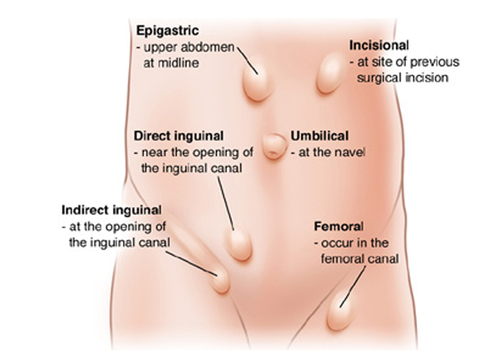Hernia Specialist Doctor in Surat - Dr. Nitin Mittal
Overview
An umbilical hernia occurs when part of your intestine sticks out through the opening in your abdominal muscles through which your umbilical cord passed before you were born. Umbilical hernias are common and typically harmless. They are most common in infants, but they can affect adults as well. In an infant, an umbilical hernia may be especially evident when the infant cries, causing the bellybutton to protrude. This is a classic sign of an umbilical hernia.
Children’s umbilical hernias often close on their own in the first two years of life, though some remain open into the fifth year or longer. Umbilical hernias that appear during adulthood are more likely to need surgical repair.
An umbilical hernia creates a soft swelling or bulge near the navel (umbilicus). In babies who have an umbilical hernia, the bulge may be visible only when they cry, cough or strain.
Umbilical hernias in children are usually painless. Umbilical hernias that appear during adulthood may cause abdominal discomfort.

Risk factors
For adults, being overweight or having multiple pregnancies may increase the risk of developing an umbilical hernia. This type of hernia tends to be more common in women.
For children, complications of an umbilical hernia are rare. Complications can occur when the protruding abdominal tissue becomes trapped (incarcerated) and can no longer be pushed back into the abdominal cavity. This reduces the blood supply to the section of trapped intestine and can lead to umbilical pain and tissue damage. If the trapped portion of intestine is completely cut off from the blood supply (strangulated hernia), tissue death (gangrene) may occur. Infection may spread throughout the abdominal cavity, causing a life-threatening situation.
Adults with umbilical hernias are somewhat more likely to experience incarceration or obstruction of the intestines. Emergency surgery is typically required to treat these complications.
Diagnosis
Treatment
Most umbilical hernias in babies close on their own by age 1 or 2. Your doctor may even be able to push the bulge back into the abdomen during a physical exam. Don’t try this on your own, however. Although some people claim a hernia can be fixed by taping a coin down over the bulge, this “fix” doesn’t help and germs may accumulate under the tape, causing infection.
For children, surgery is typically reserved for umbilical hernias that:
- Are painful
- Are slightly larger than 1/2 inch (1 to 2 centimetres) in diameter
- Are large and don’t decrease in size over the first two years of life
- Don’t disappear by age 4
- Become trapped or block the intestine
For adults, surgery is typically recommended to avoid possible complications, especially if the umbilical hernia gets bigger or becomes painful.
During surgery, a small incision is made at the base of the bellybutton. The herniated tissue is returned to the abdominal cavity, and the opening in the abdominal wall is stitched closed. In adults, surgeons often use mesh to help strengthen the abdominal wall.
Preparing for your appointment
Here’s some information to help you prepare for your appointment and know what to expect from your doctor.
What you can do
- List any signs or symptoms you or your child has had, and for how long.
- Bring in a photo of the hernia if signs of the problem aren’t always evident.
- Write down key medical information, including any other health problems and the names of any medications you or your child is taking.
- Write down questions you want to be sure to ask your doctor.
Questions to ask your doctor
- Is the swelling near my or my child’s bellybutton an umbilical hernia?
- Is the defect large enough to require surgery?
- Are any diagnostic tests needed?
- What treatment approach do you recommend, if any?
- Might surgery become an option if the hernia doesn’t get better?
- How often should I or my child be seen for follow-up exams?
- Is there any risk of complications from this hernia?
- What emergency signs and symptoms should I watch for at home?
- Do you recommend any activity restrictions?
If any additional questions occur to you during your visit, don’t hesitate to ask.
What to expect from your doctor
- When did you first notice the problem?
- Has it gotten worse over time?
- Are you or your child in pain?
- Have you or your child vomited?
- If you are the one affected, do your hobbies or your work involve heavy lifting or straining?
- Have you recently gained a significant amount of weight?
- Have you or your child recently been treated for another medical condition?
- Do you or your child have a chronic cough?

